Flowering and dormant period
It is very important to know how to care for poinsettia during flowering and dormancy. Poinsettia blooms, when bright bracts bloom on its young shoots, lasts from several weeks to months
Flowering usually occurs from December to February or from January to March. Poinsettia blooms when it's winter and daylight is very short
Poinsettia blooms, when bright bracts bloom on its young shoots, lasts from several weeks to months. Flowering usually occurs from December to February or from January to March. Poinsettia blooms when it is winter and the daylight hours are very short.
After flowering, the poinsettia, unfortunately, most often sheds its leaves and the grower thinks that she is dead. However, if you apply some tricks, you can make the poinsettia bloom a second time. In addition, if you propagate a plant, you can constantly grow new "Christmas bouquets" from its children, decorating your home with them and giving them to loved ones.
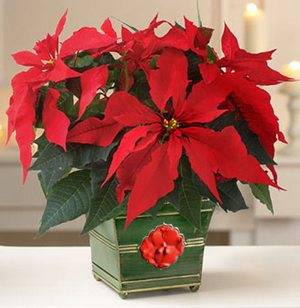 Having completed flowering in March or April, the poinsettia loses its leaves, passing into a state of dormancy, which lasts until May (about 1.5 months).
Having completed flowering in March or April, the poinsettia loses its leaves, passing into a state of dormancy, which lasts until May (about 1.5 months).
If you allow the plant to rest and save it, it will delight you with new blooms next Christmas.
To do this, you first need to cut the stems of the poinsettia, leaving only about 10 cm in length.
Then the pot with the plant must be placed in a dark and cool place with a temperature of +12 to +16 ° C, where it will stay throughout the winter until May. Resting watering should be minimal.
In order for the poinsettia to bloom again for Christmas, it is necessary to start preparing it for this from the end of September. To do this, you need to artificially create 14-15 hours of nights for the plant.
This is done simply - a cap made of thick paper is put on the poinsettia, or the plant is transferred to a dark place, where it should be for 14 hours from evening to morning. However, it must be remembered that the poinsettia must be provided with air access.
During the day, the plant should be placed in a bright place. If you perform these cunning actions within two months, the poinsettia will bloom exactly in time for the main winter holiday, and if not, only by the end of winter.
It is also very important to ensure that the shoots of the plant do not stretch too much, and the bush has a compact and neat appearance. Excessively elongated poinsettia shoots should be pruned in time
Excessively elongated poinsettia shoots should be pruned in time.
Charming poinsettia
Native to the tropics of Mexico and Central America, poinsettia belongs to the Euphorbia family. The Latin name of the plant sounds like Poinsettia pulcherrima or otherwise Euphorbia pulcherrima, which means, respectively, Poinsettia the most beautiful or Euphorbia is the most beautiful.
Surprisingly, the admirable red poinsettia flowers, thanks to which it received another name - "Christmas Star" - and not flowers at all, but leaves! Red, yellow, pink, cream, spotted or bicolor bracts are framed by modest yellow-green flowers.
Residents of many countries around the world consider poinsettia to be a real symbol of Christmas and decorate their home with it for a wonderful family holiday. "Christmas stars" are so popular that they even produce artificial decorations in the form of them!
There are various varieties of the finest poinsettia that are grown by flower growers as annuals or biennials:
Sonora White is an exquisite white beauty.
Winter Rose is a poinsettia-like winter rose.
Strawberry and Cream is a strawberry and cream plant with torn leaf edges.
Jingle Bells - Christmas poinsettia with red stars and white dots.
Polar Bear is a variety with leaves of the color of polar bear fur.
Premium Red is a classic poinsettia with scarlet leaves.
Maren is a gentle beauty with pink leaves.
Carousel Dark Red is a poinsettia with bright red wavy leaves.
Sonora White Glitter is a plant with red leaves dotted with white spots.
When choosing a poinsettia as a gift, it should be borne in mind that a plant with unblown buds will soon bloom and will delight the recipient longer.
It should be remembered that poinsettia juice is extremely toxic and can irritate the skin and mucous membranes.
All plant care operations must be carried out with rubber gloves. If poinsettia juice still gets into the eyes or mucous membranes, rinse them with plenty of water.
After caring for the plant, you must wash your hands very thoroughly with soap and water.
In addition, it is very important to place the poinsettia in an area out of the reach of children and pets.
Poinsettia care during flowering
After buying a plant in a store, it needs to be adapted to the new climate. Poinsettia does not tolerate sudden changes in temperature, drafts and cold (it can shed leaves). Place it in a shaded, draft-free place with a moderate temperature (18 - 20 ° C), hold it for 2 days, and then move it to a permanent place.
Air temperature and light during poinsettia flowering
... The brightness of the light should be sufficient, the eastern, western or southern sides of the houses near the window are suitable, the plant does not need direct sunlight - it can burn the leaves. The air temperature for poinsettia during the flowering period should be at least + 20 - + 22 ° С, but not lower than + 18 ° С.Watering and humidity
... During flowering, the poinsettia needs to be watered and sprayed often, then it will keep its bracts for a long time. It is necessary to water it with abundant warm water, after the top layer of the soil dries out, all excess water from the pan must be drained (water, after watering, should not remain in the plate for more than 30 minutes) so that the soil is not waterlogged. To ensure adequate humidity, the poinsettia should be sprayed with soft (so as not to leave streaks) water at room temperature 2 times a day.
During flowering, the poinsettia does not need to be repotted or nourished.
Poinsettia after purchase. Personal experience.
To make it clearer, we purchased a poinsettia. In a regular supermarket. Every December they are sold almost everywhere. We bought what came first. The bush is small, planted in a large pot, there are not a lot of green leaves and, in addition, the trunk is loose. By all indications, it is a non-resident. Let's try to save him.
1. Poinsettia transplant after purchase.
We usually recommend replanting the plant after purchase. But in our case, it was decided to leave it in the same soil, until spring. Poinsettia is very weak during the flowering period, so it may not tolerate a transplant. In general, floriculture is a creative process. In our business it is impossible to give clear instructions on how to proceed. Better to focus on expediency. A sturdy plant can be transplanted into a new substrate. To do this, it is better to use store-bought begonias soil, mixing it with a lot of vermiculite. Drainage must be placed at the bottom of the pot. The poinsettia container should be the same in top diameter and height. The size of the pot should be half the diameter of the crown of the plant. This will allow the roots to be moderately moisturized and at the same time free access of air will be provided. In our case, the soil dried out quickly enough, so there was no risk of flooding the plant.
Wilting leaves
2. Poinsettia after purchase care.
For the first watering, a solution of Aktara was prepared. This turned out to be very timely, as later the dead scabbards were found. Aktara is very effective against sucking insects. After 3 days, the leaves began to dry out. In principle, this was expected. Still, the stress is very great. In order to make it easier for the plant to overcome it, it was decided to start treatment with an aqueous solution Epin Extra... This must be done during the entire flowering period. After the first treatment, the poinsettia began to look better. To prevent the barrel from wobbling, it was tied to a stick. Use warm water to water poinsettias. If the plant remains in the same soil in which it was purchased, periodic watering with fungicidal preparations is necessary. For the prevention of fungal diseases of the root system. In our case, Fitosporin was used.
3. Poinsettia after purchase. About humidity.
Spraying is often recommended to increase air humidity. In my experience, spraying plants is only useful in the summer months of extreme heat. And even then, subject to the main conditions, such as bright light and regular watering, there is practically no need to increase the humidity. Spraying is still a secondary care method. They can be completely neglected. Usually, flower growers begin to intensively spray the plants if they notice any drying out of the leaves. But as a rule, this is not due to low humidity. Most often, the leaves dry out from low light and irregular watering. Why? Because the lack of light leads to a weak formation of organic substances necessary for nutrition. Accordingly, such a plant is not able to build up a sufficient root mass to fully supply the leaves with water. Due to irregular watering, some of the roots dry out, or rot (depending on the actions of the grower). This also does not contribute to the full supply of water to the foliage. Therefore, my poinsettia, I will not spray. Leaves dry for very different reasons.
4. Poinsettia after purchase. The beginning of growth.
And so, bright lighting, moderate watering with warm water, after drying the upper layer of the substrate, as well as treatments with anti-stress and antifungal drugs, did their job. The poinsettia began to grow. Most of the green and red leaves were preserved, the buds swelled. At this stage, we can say that the plant has adapted well to the conditions of the room. Epin and fungicide treatments are no longer needed. Now you can calm down, the poinsettia will definitely not die. The main thing is not to start watering more abundantly, so to speak, "for joy." After the plant sheds red leaves, it will need to be cut, watering reduced, and, if possible, placed in a cool, bright place. This is necessary to ensure a resting period. Its duration is 2 months.
Poinsettia is the most beautiful - how to care at home
Many people think that the flower is not suitable for long-term cultivation, because after the winter holidays it begins to wither and lose its presentable appearance. However, if you know all the rules of caring for a "Christmas star", it can live for many years, every winter "lighting up" with a bright light.
Poinsettia adaptation
As a rule, the plant comes to us as adults.
If you bought it from a store, then it's important to get it home so it doesn't freeze. The "Christmas star" must be well packed before transportation.
Very often, flowers are marketed waterlogged, so the roots can rot from low temperatures. Therefore, try to choose specimens that are not too flooded with water.
When buying poinsettia, pay attention to the flowers: if they look like unblown buds, then the plant will delight with flowering for a long time. When the plant arrives home, it must be placed on a light-colored windowsill.
Poinsettia does not like too high temperatures and drafts. She lives most comfortably at a temperature of 15 ° C.
When the plant arrives home, it should be placed on a light-colored windowsill. Poinsettia does not like too high temperatures and drafts. She lives most comfortably at a temperature of 15 ° C.
The "Christmas star" gets used to the new environment for 3-4 weeks. During this time, the plant can be watered little by little, and sometimes sprayed. The soil in the pot should not dry out.
Plant pruning
As soon as the small yellow flowers in the center of the huge red bracts begin to fade, the plant begins a dormant period. This usually happens in February-March.
To ensure that flower buds are set for the next year, the flower needs to be cut by about half. Only 3-5 buds should remain on the plant. In this form, the flower should be kept for 2 months, stopping watering.
Transplant "Christmas star"
In early spring, the flower can be transplanted into a larger container. The soil should be fertile, it is made up of 1 part peat, 1 part sand, 3 parts garden soil and 3 parts humus. From now on, the poinsettia can be kept at higher temperatures than before. Gradually, the "Christmas star" will begin to build up the green mass. The strongest shoots should be left on the plant, and the rest can be cut into cuttings.
The transplanted plant should be placed on the window, where it will take "sunbathing" only in the morning. To prevent the "Christmas star" from getting burned leaves, the rest of the time it needs to be shaded.
Watering, feeding and shaping
In the spring and during the growing season, poinsettia requires watering as the soil dries out. It is best to moisten the substrate in the container gradually, adding water in portions.
The “Christmas star” should be fed every month, starting from the 2nd week after transplanting. A complex fertilizer in liquid form (with a high potassium content or based on vermicompost) is suitable for this. Top dressing is usually continued until autumn, when the time comes for the plant to bloom.
To make the flower look elegant, you can pinch it throughout the growing season. This will allow you to control the shape of the green mass. You can shorten the shoots so that they do not stretch out until August: at this time the formation of flower buds begins.
How to care for poinsettia?
In order for the spurge to be healthy and to please the owners, it is necessary to take good care of it.
Where to place the flower?
Poinsettia does not tolerate drafts and exposure to direct sunlight. It is best to place it on the east or west side of the house. In the summer, it is better to move the plant to fresh air, and if this is not possible, then it is necessary to ventilate the room where it is located.
In winter, it is necessary to provide additional lighting so that the flower does not shed its leaves. For this, you can use specialized phyto lamps or fluorescent lamps.
Watering mode
It should be at room temperature
During flowering, in winter, it is important to water the poinsettia with warm water, the temperature of which is a couple of degrees higher than the indoor air temperature
Otherwise, the flower may shed its beautiful leaves. Try to avoid excessive soil moisture, as well as aridity. Excess water must be drained from the pan a few minutes after watering.
Indoor humidity
Too dry air only interferes with the growth of euphorbia. Spraying with warm water saves the day. It is best to do this daily.
Poinsettia feels extremely good and comfortable in high humidity. During the dormant period, from February to March, air spraying can be stopped, and from April, that is, from the moment new shoots appear, spraying must be resumed.
Top dressing and fertilizers
From spring to autumn, every two weeks it is necessary to feed the plant with mineral fertilizers. Use complex liquid or granular mineral fertilizers for indoor flowers. Before flowering, in early autumn, you can add potassium and phosphorus salts.
The soil
The flowerpot must be spacious so that the plant can grow in it for about 3-4 years.
A pot that is too large can retain excess moisture, and with frequent watering and poor drainage, the roots can rot.
Transfer
The flower needs to be replanted every year. This procedure is carried out at the end of spring. Two months before this, the stems must be cut by a third. The poinsettia is placed in a warm room with sufficient sunlight and watered daily with warm water. As soon as the leaves appear, the flower can be transplanted into a pot slightly larger than the first one.
At the bottom of the pot, you need to lay out a layer of drainage, for example, expanded clay, and then fill it with prepared fresh soil. An earthen ball with a poinsettia is installed in the center of the pot. You need to try not to scatter it and not damage the fragile roots. If the roots are damaged, then they need to be cut off, and the cut site should be treated with activated carbon. If there are free places, then fill them with soil, and all the roots were placed in the ground.
Place the poinsettia in a warm place before planting it. The room temperature should not exceed 20 degrees. Now you can start watering the flower abundantly. When the first shoots appear, only 6-7 of the strongest should be left, and the weak should be cut off.
Pruning
Euphorbia usually grows extremely rapidly. To prevent the flower from becoming too large, it must be pruned periodically. The flower is trimmed, leaving stems about 10 cm high from the ground. Further, the beautiful shape of the flower crown is simply maintained.
Diseases, pests and possible problems
Low air humidity is good conditions for the emergence and reproduction of spider mites. On closer inspection of the plant, you can see a white cobweb on the back of the leaf. If the lesion is small, it will be enough to rinse the foliage well. You can use special acaricides that are aimed at destroying insects. For prevention, it is sometimes advised to spray the flower with warm water.
Other pests can also settle on the leaves of the plant. Among them, the most common are aphids and mealybugs. At an early stage of the lesion, it is easy to deal with it by treating the foliage with soapy water, then rinsing with a warm shower.
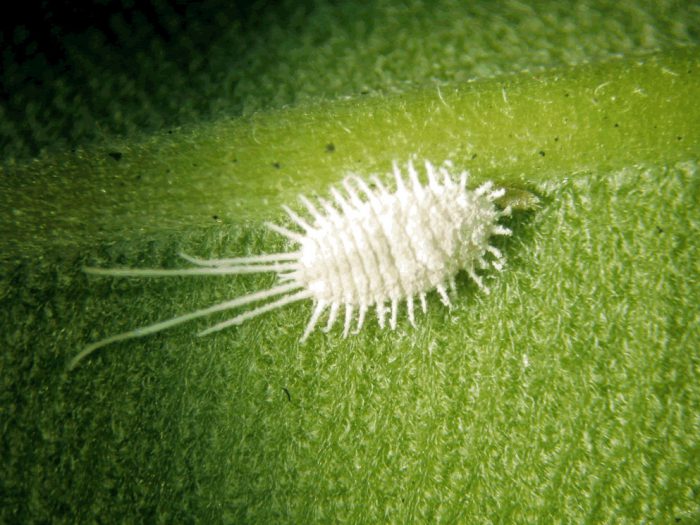
Mealybug
When carrying out such a manipulation, cover the soil tightly with a film. If there are a lot of pests, you should use special products, which can be purchased at any flower shop. If gray spots appear on the lower parts of the plant, this is gray rot. The affected areas should be cut off, and the flower should be treated with an antifungal drug.
Basically, poinsettia blooms precisely on New Year's holidays, because the flower received another name - the Christmas tree. If this does not happen, growers are advised to stimulate flowering. In order to make the plant bloom for Christmas, you should start preparing in September.
In captivity, the flower forms buds with a short daylight hours. Therefore, in the fall, they artificially create longer nights (14-15 hours a day). In the dark, it is necessary to cover the plant with dense material (you can use a dark bag) for two months.
The flower should be without light for 14 hours - you can simply transfer the flowerpot to a dark place overnight. We must not forget that poinsettia also breathes and needs access to fresh air. The flower should be covered in such a way that air flows freely to the plant.
What it is?
Poinsettia has many names, among which one can single out quite popular and fully characterizing the appearance of a flower during flowering - "Christmas Star". Florists use another name for the plant - the most beautiful euphorbia. According to some beliefs, it is this culture that is a symbol of the hearth and harmony in the house.
A feature of this decorative culture is the period of its flowering, which falls exactly on the Christmas holidays. At home, the flower is transformed due to the appearance of flowers with inflorescences, which outwardly resemble a New Year's decoration-star. However, the culture owes its attractive appearance not to the flowers at all, but precisely to the inflorescences bordering the rather small and nondescript buds located inside. The bracts themselves are leaves that differ from the usual green mass, appearing only at the time of flowering of an indoor ornamental plant.
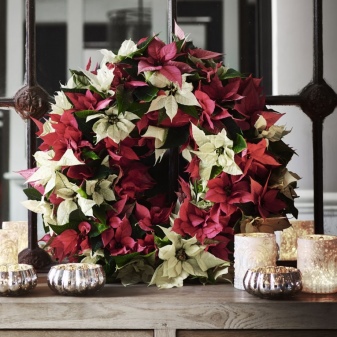

Poinsettia stands out for its unpretentiousness in terms of conditions for growth and development, so anyone can grow a blooming culture in a pot at home. Quite often, it is cultivated for the decoration of public premises in winter on the eve of the New Year holidays. In addition, poinsettia can be a successful and rather symbolic present.
Mexico is considered the birthplace of this flower, since it was there that this plant from the Euphorbia family was first discovered. In the course of studying this culture, it was found that the milky juice of this particular plant was extracted by the Indians for the preparation of a drug that would cure a fever. In addition, poinsettia was actively used by indigenous peoples in the manufacture of natural dyes for fabrics, as well as for cosmetics.

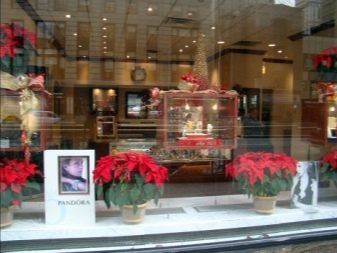
At the end of the 19th century, the culture was brought to America, where they began to grow it in botanical gardens, as well as in greenhouses. This popularity was due to the high decorative qualities of the "Christmas Star", which eventually appeared in Europe. The main area where the culture was used was amateur and professional gardening. In the first case, the flower was grown to decorate the home for Christmas, in the second - as a copy for exhibitions, as well as subsequent sale.
As for the post-Soviet space, the most beautiful euphorbia became in demand as a decorative indoor culture only at the end of the 20th century.
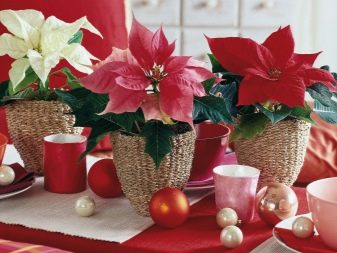
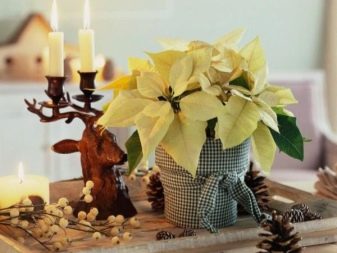
Considering the development of poinsettia in its natural environment, it should be noted that the plant is a green perennial, which can reach a height of about four meters as it grows. The culture has perfectly adapted to the hot and arid climate with a rare ingress of moisture into the soil. Externally, the foliage of the flower has an ovoid elliptical shape with jagged edges. The length of the leaves ranges from 15 centimeters.
The flowers of the plant are painted in white-yellow shades, they are formed in the form of small inflorescences, which form a rosette on the crown of the flower. Before it begins to form flowers, bracts appear, which retain their viability for several months.

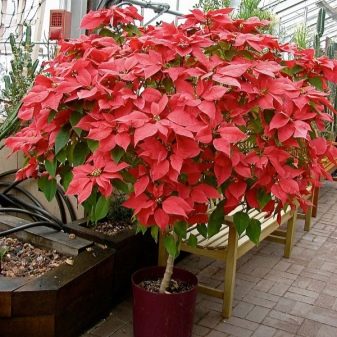
If you properly care for the culture indoors, then it usually reaches a small size, which rarely exceeds the mark of half a meter. In this case, the bracts reach a length of 10-15 centimeters, with a width of about 6 centimeters. The flower stalks of the culture are quite spreading, their diameter will be in the range of 20-30 centimeters.
In species of the most beautiful milkweed that grows in their natural environment, the bracts are always red. They contrast beautifully with the dark green leaves. However, modern plant breeders have produced plants that stand out in completely incredible colors, which are not limited to a single color palette in color.
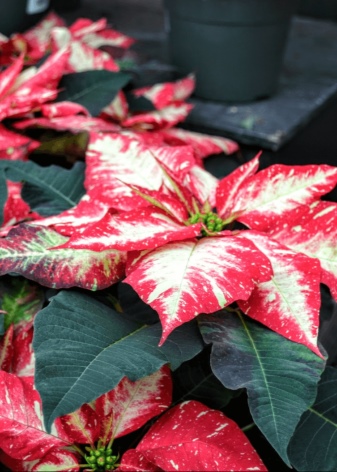
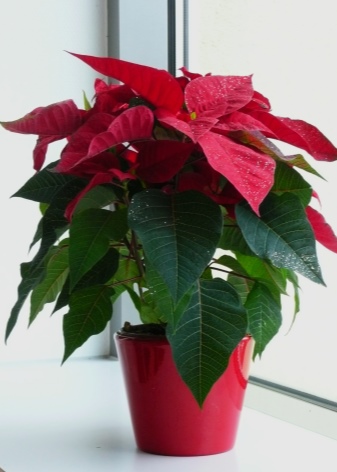
Possible growing problems and diseases
Growing a Christmas star can be tricky.
Drops buds and leaves
Euphorbia can shed foliage for two reasons:
- Freezing of a flower when in a draft.
- Natural process. After the plant has faded, it needs rest.
In this case, you should cut the stems in half and put the flower pot in a semi-dark room, where the temperature is not less than 10 ° C. Watering should be moderate. After 1.5 months, the poinsettia will wake up again and begin to turn green.
Leaves turn pale
Some people notice this phenomenon when the leaves become pale. The reason lies in the fact that the room is hot, there is dry air. Frequent spraying of the foliage can solve this problem.

Pale leaves indicate too dry air in the room.
Important! To prevent pallor, the milkweed pot should be moved to another room where it is not so hot.
The tips of the leaves dry
Drying of the tips indicates that the room temperature is too high. You can save the plant in the same way as with the pallor of the leaves.
Pests
The most common insect pests that colonize the Christmas star are:
- mealybug;
- scabbards;
- thrips;
- whitefly;
- spider mite.
To get rid of them, it is recommended to spray the plant with insecticides, for example, "Aktara", "Aktellikom", "Decis", "Inta-virom".
Diseases
Most often, euphorbia can hurt:
- gray rot;
- powdery mildew.
Gray mold usually affects the flower when it lives in a humid environment. The disease can be recognized by a gray bloom that appears on the stems, inflorescences, and brown spots become visible on the leaves. If you do not start to treat the plant in time, then all the leaves can dry out and fall off.
Note! Preparations for fighting gray rot: "Skor", "Fundazol", "Celandine"
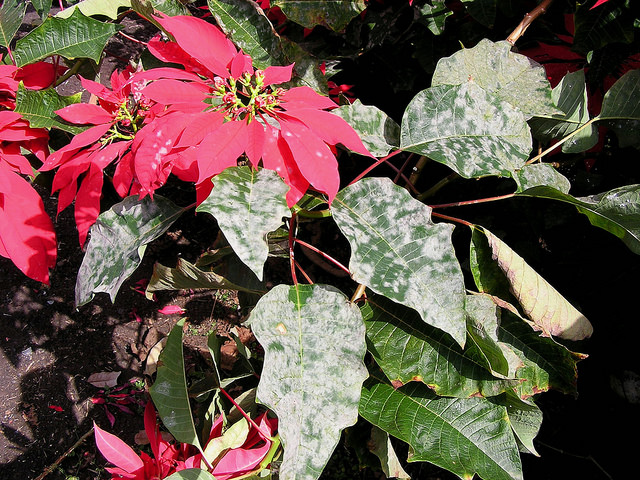
Leaves affected by powdery mildew
Powdery mildew appears as a white bloom on the leaves, flowers that look like flour. Later, it may darken, which means the disease develops. In the fight against powdery mildew it is necessary to use "Topaz", "Fitosporin-M", "Skor".
Growing
Poinsettia is usually bought in a store or received as a Christmas present. After the flower has faded, it will most likely die, but if kept properly, the poinsettia will become a real long-bloom. Observe the following tips:
- Reduce watering during the period when the leaves begin to fall off. At the same time, it is necessary to stop fertilizing the soil, and also to shorten the shoots by 10-15 cm. After that, the plant must be placed in a dark, cool place until May.
- In May, the poinsettia begins to grow actively, so move it to a sunnier place. Start feeding the flower with mineral fertilizers. Then transplant it into a new substrate.
- In October, it is better to put the poinsettia in a box at night, or put it in a closet where sunlight does not penetrate.
- Once the plant has opened the bracts, you can return to normal mode.
Do not forget that milkweed juice is poisonous. This poison can cause great harm to the eyes if accidentally gets into them. Poinsettia juice also provokes various allergic reactions. May cause intestinal poisoning and upset if swallowed. When working with a flower, it is better to use gloves.
Difficulties that may arise when growing

- The leaves turn yellow and fall off. This means that the flower must be removed from the draft.
- If strange spots appear, and the flowers become paler, then adjust the watering mode. Most likely, the flower is receiving too much water.
- Both leaves and inflorescences fall off. This means that the soil is too wet.
- If the inflorescences fall off, and the leaves become brownish, then check the dryness of the air in the room.
- Leaves fall sharply in case of hypothermia of the plant.
Home care
Christmas star in care - the plant is completely unpretentious, it will grow without any problems in any corner of an apartment or office.
The only thing you have to take care of is the required amount of light and the ambient temperature.
Watering
During flowering, which occurs in winter, as well as during the growth phase - in summer, the plant requires abundant watering. The earthen coma should not be allowed to dry out, but stagnation of water will also be destructive. The main indicator for irrigation is a slight drying out of the upper part of the soil. After watering, the water in the pan is left for an hour and then drained.
In autumn and spring, the star of Bethlehem begins periods of rest, during which watering is carried out in minimal quantities, but without drying out the land.
The water used for irrigation should be warm (room temperature) and well-separated.
Air humidity
Dry and warm air is bad for the plant. With low humidity in the apartment, the beautiful poinsettia should be regularly sprayed with water (1-2 times a day). This is especially true in winter during the period of active operation of central heating batteries. A good solution would be to locate the plant pot on a pallet with wet gravel or expanded clay.
The main sign of dry indoor air is the yellowing of the ends of the leaves, followed by their discharge.
Temperature regime
Poinsettia is a thermophilic plant, the lowest possible temperature for it is +15 degrees.
During the period of active growth (in summer), the room temperature should be + 20-22 degrees. It must be maintained at this level until mid-October. From this moment, the period of budding and flowering begins, when the temperature should be + 17-19 degrees. It should be noted that at low temperatures, the color of the bracts becomes brighter, at the same time, at higher temperatures, the size of the bracts increases.
Poinsettia growth slows down if the nighttime temperature is higher than the daytime.
Top dressing (fertilization)
Top dressing is applied in two stages.
In spring and summer, during the growth period, universal fertilizers with nitrogen, phosphorus and potassium content, or fertilizers for ornamental deciduous plants with an increased nitrogen content, are used. A serious impetus to growth is given by humus, humus or bird droppings.
In September-November, once a week, you can apply fertilizer for decorative flowering plants. During flowering, any feeding stops.
Pruning
Pruning is beneficial for poinsettia. To stimulate growth in March, all shoots are shortened by about 1/3, while each should have at least 5 new buds. The shoots remaining from the procedure can be rooted, and new plants can be obtained.
In the summer, it is allowed to periodically carry out formative pruning, pinching the tops.
Light mode
In the summer, when the phase of active growth passes, the flower must be provided with lighting for more than 12 hours a day. At the same time, direct sunlight comes up until noon, after which the pot is covered from direct rays so that the lighting is bright, but diffused.
A decrease in daylight hours to less than 12 hours is a sign of a blooming season for a Christmas star. First, the staining of the bracts occurs.
From the end of September, it is very important to cover the pot at night from any possible light, including moonlight or artificial lighting (in an apartment, street, etc.)
This can be done by covering it with a cardboard box or thick plastic bag. For 10 weeks, the plant should be in complete darkness every day for at least 14 hours.
ATTENTION! Even the slightest amount of light can knock the internal timer of the beautiful poinsettia and delay the flowering time.
Life span
The plant is perennial, and therefore, with proper care, it can live for many years. It is permissible to grow the Christmas star as an annual, or completely renew it every 2-3 years from cuttings.
There is no smell of poinsettia flowers.
Growth per year
The growth period is summer, so if the star of Bethlehem is acquired already in bloom, then in the same season it will no longer grow. After resting and pruning in spring, it grows rapidly, adding 30 to 45 cm in height during the summer months.


